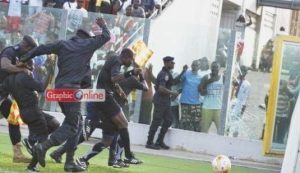The ugly scene: Hooliganism in Nzema Football.
The bad side of our football
Football Hooliganism is a disorderly violent behaviour perpetrated by spectators at a football events.
It normally involves conflicts between gangs to intimidate and attack supporters of other teams.
Conflicts may take place before, during and after matches, participants often select locations away from the stadiums to avoid arrest by police, but conflict can also erupt spontaneously inside stadium or in the surrounding streets, in extreme cases Hooligaans , polices and bystanders have been killed and riot police have intervened.

Hooligans who have the time and money may even follow National teams to away matches and engage in hooligan behaviour against hooligans of the home team. They may also become involved in disorders involving the general public while National level firms so not exist in the National teams may use collective name indicating allegiance.
It is believed the first instance of football violence is unknown, but the phenomenon can be traced back in the 14th century England. In 1314, Edward II banned football, at a time violent unruly activity involving rival villages Kicking pig’s bladder across the local health , because he is believed the disorder surrounding matched might lead to social unrest and even tresons.
In Ghana,up to 127 people died and hundreds were injured when football fans stampeded at a match in Accra in 2001. Accra Hearts of Oak were leading 2:1 against bittest rivals Kumasi Asante Kotoko in the Ghana version of El-Classico with five minutes left in the game some fans began throwing bottlesand chairs on the pitch, Police then fired tear gas into the crowd sparking a panic. Fans rushed to escape the gas and in the ensuing crush, up to 127 people were killed.
Asante Kotoko also faced a ban after fans assaulted the referee in a CAF Confederation cup against Tunisian side Etoile Sportive Du Sahel.

The story of holliganism can’t be left out as far as football is concern on Nzemaland. Just recently three major incidence has happened which involves players,referees, supporters and technical bench.
Recently with the ongoing Alabokazo community gala which comprises of twelve communities, same incidence has been repeated with two supporters slapping the center man for allegedly awarding a penalty in the dying embers of the game against his team and also ignoring their own call of penalty.
They chased up the referee if not the intervention of some community leadership he would have been beaten to death.

Lack of security has been a major talking point and some believes it is the major causes of the violence and ugly incident we encounter.
Last year at the West End Radio independence cup ( WEISFA) supporters and club owners fought and had several crash with the police with reasons unknown up to date.
In the regional aspect as a whole, hooliganism has caused a major problems to some traditional clubs mostly having themselves in the lower division of our football. Tarkwa United, Eleven Wise, Prestea Mine stars, Okwawu United and a few notable clubs have been victimized with these uncharacteristic acts.
Behaviours that causes hooliganism
Football hooliganism involves a wide range of behaviour, including:
taunting
spitting
unarmed fighting
throwing of objects on to the pitch, either in an attempt to harm players and officials or as a gesture of insult.
throwing of objects at opposing supporters, including stones, bricks, coins, flares and Molotov cocktails.
fighting with weapons including sports bats, glass bottles, rocks, rebar, knives, machetes and firearms.
disorderly crowd behaviour such as pushing, which may cause stadium fixtures such as fences and walls to collapse. Similar effects can occur when law-abiding crowds try to flee disorder caused by hooligans.
In some places, there is vandalism in the form of graffiti sprayed to promote football teams, especially in derby cities.
Anti Hooligan Measures
Police and civil authorities in various countries with hooligan problems have taken a number of measures, including:
banning items that could be used as weapons or missiles in stadiums, and searching suspected hooligans
banning identified hooligans from stadiums, either formally via judicial orders, or informally by denying them admittance on the day
moving to all-seated stadiums, which reduces the risk of disorderly crowd movement
segregating opposing fans, and fencing enclosures to keep fans away from each other and off the pitch
banning opposing fans from matches and/or ordering specific matches to be played
behind closed doors
compiling registers of known hooligans
restricting the ability of known hooligans to travel overseas.
The question is when and how can we put an end to these ugly acts of conducts in our beautiful game.
By: Domesticsportsgh reporting team
Credits: Benjamin Bonzoh-Benzyma
Disclaimer
Domesticsportsgh.com is not responsible for the reportage or opinions of contributors published on the website. Read our disclaimer.
Send your news stories to the director via WhatsApp on +233 205004646 or email enyansamul@gmail.com




